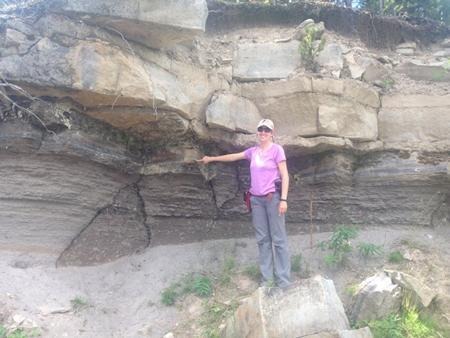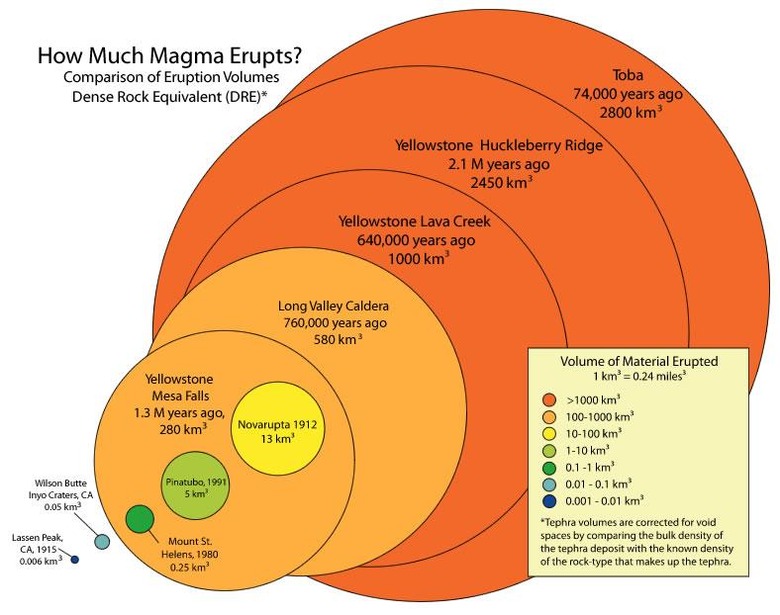This Yellowstone Study Just Cut Our Potential Apocalypse Timeline
An extinction level event had its likely arrival date changed thanks to a study performed in Yellowstone and reported this week. Yellowstone National Park has a supervolcano under it that'll one day erupt and likely kill most life on Earth. Arizona State's Hannah Shamloo studied Yellowstone's Lava Creek Tuff over a period of weeks to discover a set of relatively shocking conclusions.
The supervolcano under Yellowstone has the potential to spew forth a supereruption. That's like an eruption from a volcano, but far more super – like change-the-climate big. Eruptions of hotspots within Yellowstone have happened more than once before.
"If something like this happened today, it would be catastrophic," said Shamloo. "We want to understand what triggers these eruptions, so we can set up warning systems. That's the big-picture goal."

The image above comes from EOS and was captured by Shamloo. This image depicts Christy Till as she "points at an ash layer within the Lava Creek Tuff at the study site near Flagg Ranch, Wyo., just south of the Yellowstone boundary."
Of note: Shamloo worked with Christy Till on this project. Till is a geologist and Assistant Professor in the School of Earth and Space Exploration at Arizona State.
Supervolcano Eruptions (likely incomplete list)
• Bruneau-Jarbidge caldera 11,830,000 years ago
• Heise volcanic field 6,400,000 years ago
• Heise Volcanic Field 6,000,000 years ago
• Heise Volcanic Field 4,500,000 years ago
• Huckleberry Ridge 2,100,000 years ago
• Henry's Fork Caldera 1,300,000 years ago
• Lava Creek Tuff 640,000 years ago
Some of the more notable eruptions can be found in the Magma chart below. This chart comes from the Yellowstone Volcano Observatory.

At Yellowstone's Lava Creek Tuff, Arizona State University's Hannah Shamloo collected samples of rhyolite ash. She spent weeks collecting samples, then analyzing their contents. Inside the rocky ash, She looked for crystals called phenocrysts.

ABOVE: "Feldspar phenocrysts from the Lava Creek Tuff. The outermost layers, which contain tiny bits of glass, are to the left. The phenocryst may be a fraction of a larger crystal that grew within the magma chamber or may have adhered to a different crystal on the right, explaining why layers are roughly vertical rather than concentric. Red represents the path of an electron microprobe, which cut through layers to collect chemical compositions." VIA EOS, Images by Hannah Shamloo.
SEE ALSO: NASA explains why the world didn't end on September 23rd, 2017
The speed at which the crystals formed can be seen in the composition in which their molecules were arranged when analyzed. Magma surrounding the crystals immediately before the most recent Yellowstone eruption are represented by the now-outermost rims of the crystals. It is in these outer rims that the time between a trigger event and an eruption can be found.
The size of each unique arrangement of molecules in a crystal show the speed at which they formed. In the case of the crystals found in the stones found at Lava Creek Tuff, change occurred quickly, especially near their outer rim. Faster formation of this outer rim means a shorter time between the trigger for an eruption and a full eruption – AKA in this case, a supereruption.
The materials in which the phenocrysts were found were analyzed with the software called MELTS. This software is able to show how factors like water content, temperature, and pressure influenced the composition of the crystals therein. Due to an extremely small amount of water found in this part of the study, Shamloo suggests that the most recent eruption happened as a result of magma injection.
BEHOLD: Yellowstone's 12 known supereruptions
"It's shocking how little time is required to take a volcanic system from being quiet and sitting there to the edge of an eruption" said Shamloo, VIA NYTimes at the August IAVCEI 2017 – that's the International Association of Volcanology and Chemistry.
The results of Shamloo's study seem to defy previous assumptions about volcanic trigger-to-eruption timescale. It was previously assumed that it would take thousands of years between a trigger – like a magma injection – and a final eruption. Shamloo suggests that this time scale could fit within decades.
